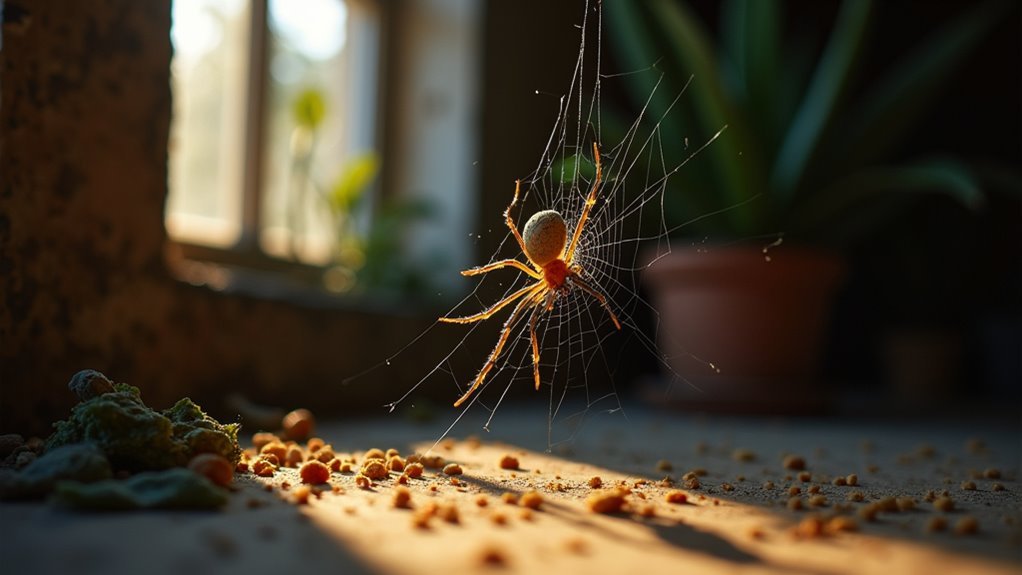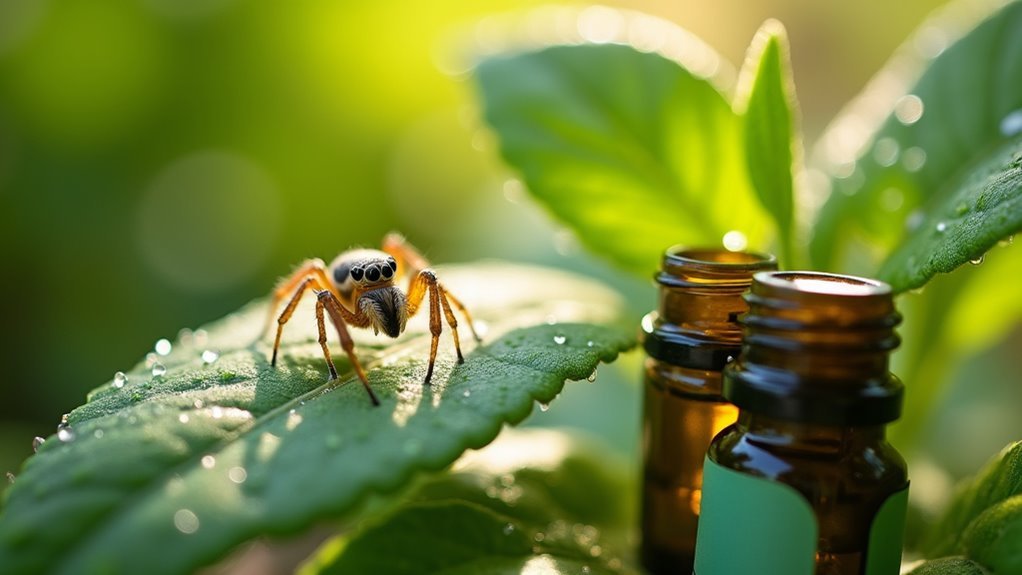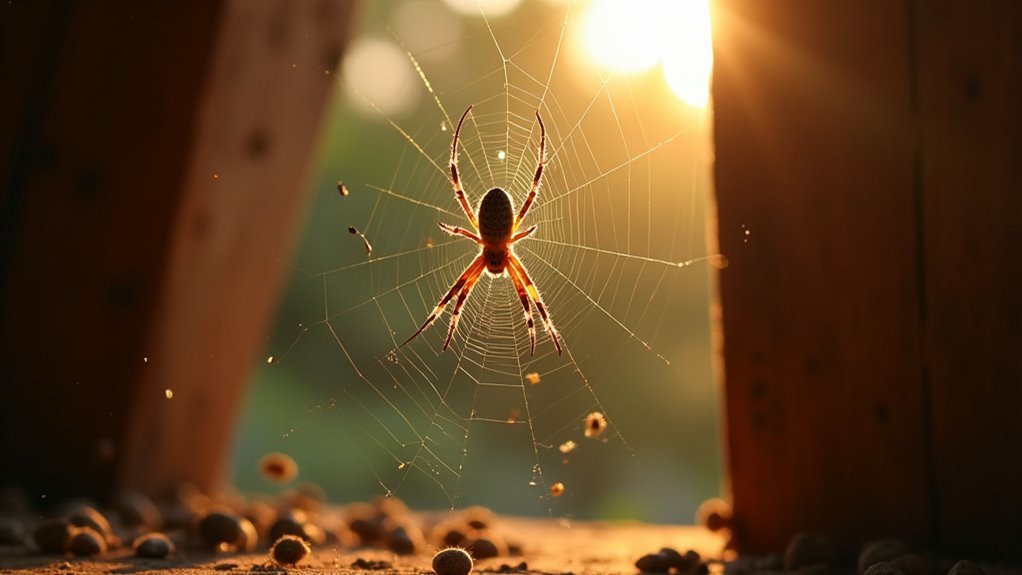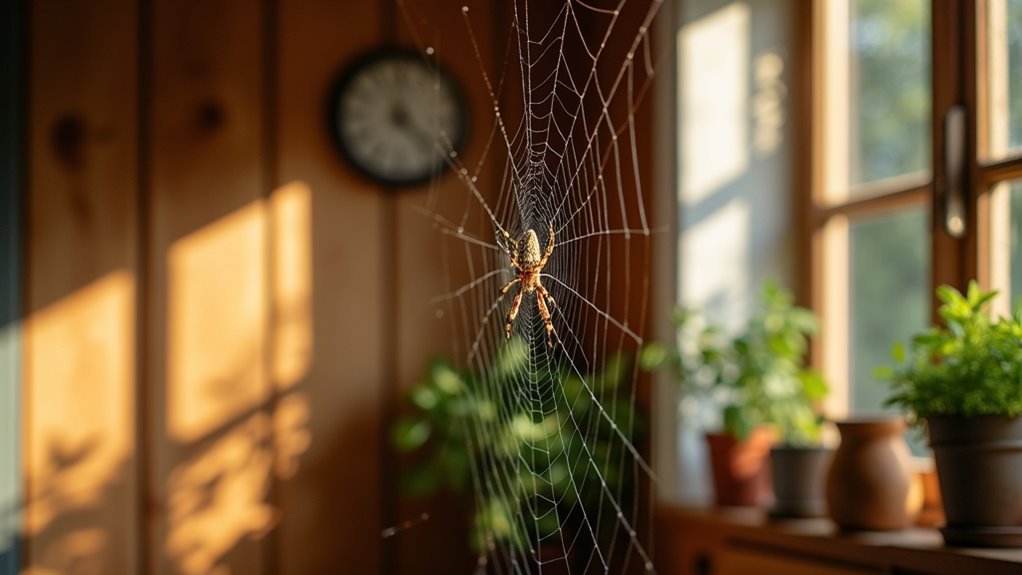Spiders enter your home seeking warmth, shelter, and food sources like flies and mosquitoes. They slip through cracks in windows, doors, gaps around pipes, and unsealed vents. You can naturally repel them using essential oils like peppermint or tea tree oil, citrus peels, and vinegar solutions. Keep your home clutter-free, reduce humidity, and maintain regular cleaning to eliminate webs and hiding spots. Understanding these attraction factors and implementing strategic natural deterrents will help you create an effective spider-free environment.
Understanding What Attracts Spiders to Your Home

When temperatures drop and insects swarm around your outdoor lights, you’re unknowingly rolling out the welcome mat for spiders. These eight-legged pests aren’t just randomly wandering into your home—they’re following specific attractants that draw them indoors.
Spiders primarily seek warmth and shelter, especially during harsh weather conditions. Your heated home provides the perfect refuge from outdoor extremes. However, temperature isn’t their only motivation. Abundant food sources, particularly flies and mosquitoes, attract spiders who hunt these insects for survival.
Your cozy, heated home serves as an irresistible winter retreat for spiders seeking both warmth and their next meal.
Moisture-rich areas like bathrooms and kitchens create ideal spider habitats, while cluttered spaces offer countless hiding spots.
Bright exterior lighting compounds the problem by drawing insects closer to your home’s entry points. Understanding these attractants is essential for effective prevention strategies that’ll keep spiders outside where they belong.
Sealing Entry Points and Structural Vulnerabilities
Now that you know what draws spiders inside, you can take targeted action to block their access routes.
Sealing entry points starts with identifying structural vulnerabilities around your home. Inspect for gaps and cracks around windows and doors, foundation areas, and anywhere pipes enter your walls.
Apply weather stripping to doors and use caulk to fill wall cracks and seal around plumbing penetrations. Check that windows close tightly and replace damaged screens that allow easy indoor access.
These simple repairs eliminate pathways spiders use to infiltrate your home. Regular maintenance of your exterior prevents new entry points from developing.
Inspect wood siding and roofing for damage that creates fresh vulnerabilities. When structural issues seem overwhelming, pest control professionals can assess problem areas you might’ve missed.
Natural Repellents Using Essential Oils and Plant-Based Solutions

While sealing entry points creates a physical barrier, natural repellents offer an additional layer of defense that’s both safe and effective.
Essential oils like peppermint oil, lavender, and tea tree oil work exceptionally well when mixed with water and sprayed around entry points. You’ll find these plant-based solutions particularly useful for ongoing spider management.
Citrus peels from oranges and lemons naturally keep spiders at bay due to their potent scent. Simply place them near doorways and windows to prevent their entry.
A vinegar solution using equal parts vinegar and water creates another powerful deterrent when sprayed in spider-prone areas.
Crushing horse chestnuts or walnuts near entry points adds extra protection.
Maintaining Cleanliness to Eliminate Spider Habitats
Beyond applying natural repellents, maintaining a clean home environment serves as your most effective long-term strategy for eliminating spider habitats.
Regular vacuuming of floors and corners removes webs, eggs, and spiders directly while cleaning surfaces in kitchens eliminates crumbs that reduce food source availability for spiders.
You’ll want to organize storage areas using plastic bins instead of cardboard boxes to minimize potential hiding spots.
Creating a clutter-free environment makes your home less appealing to spiders by decreasing available shelter.
Inspect closets and storage areas frequently for spider activity signs, allowing for early intervention before infestations establish.
This systematic approach to maintaining cleanliness disrupts spider life cycles and removes the conditions they need to thrive indoors.
Controlling Food Sources by Managing Other Insects

You’ll find that spiders aren’t randomly invading your home – they’re following their dinner.
These eight-legged hunters are drawn indoors by common prey like flies, mosquitoes, moths, and other small insects that’ve already made themselves comfortable in your living space.
When you eliminate these food sources through targeted insect control methods, you’re fundamentally removing the primary reason spiders want to stick around.
Common Spider Prey
The presence of abundant insect prey acts as a dinner bell for spiders seeking to establish territory in your home. Understanding what attracts spiders helps you control the spider population more effectively.
Common household insects that serve as their primary food source include flies, mosquitoes, moths, gnats, and ants. These pest varieties create an irresistible buffet that draws spiders indoors.
You can prevent spider invasions by targeting these insects first. Focus your efforts on eliminating flies around garbage areas, mosquitoes near standing water, and moths attracted to lights.
Regular cleaning removes food debris that attracts these insects. Natural remedies like essential oil sprays deter both insects and spiders simultaneously.
Effective Insect Control
Success in spider prevention depends on implementing targeted strategies that tackle insect populations at their source. Effective methods include regular cleaning to eliminate crumbs and spills that attract flies and mosquitoes.
You’ll reduce insect activity by maintaining clutter-free spaces and implementing pest management techniques like insect traps and baits. These approaches directly impact spider control since fewer insects mean less available food for spiders.
Habitat modification plays an essential role in keeping your home less appealing to both insects and spiders. Regular inspections help identify problem areas before infestations develop.
While natural spider repellents can supplement your efforts, controlling the food chain proves more sustainable. By consistently managing insect populations through sanitation and targeted treatments, you’ll effectively prevent spiders from entering your home seeking prey.
Creating an Unwelcoming Environment Through Lighting and Moisture Control
Since spiders actively seek out specific environmental conditions to thrive, you can discourage them by controlling two key factors: lighting and moisture levels around your home.
Replace bright exterior lights with yellow bug lights to deter spiders from gathering around entry points at night. Keep your living spaces well-ventilated and brightly lit, as spiders prefer darker, undisturbed habitats.
Address moisture problems throughout your home, particularly in damp areas like basements and bathrooms where spiders find water sources.
Maintain dry conditions in crawl spaces and storage areas to prevent creating appealing environments. Keep outdoor areas clear of debris that could harbor spiders near potential entry points.
Seasonal Prevention Strategies for Year-Round Protection
While each season brings unique spider challenges, adapting your prevention strategies throughout the year guarantees consistent protection from unwanted arachnid visitors.
During fall, spiders often enter homes seeking warmth, so seal potential entry points and maintain a clean environment.
As temperatures drop, spiders migrate indoors for shelter, making fall the critical time to fortify your home’s defenses.
Spring and summer’s increased insect activity requires effective strategies like implementing pest control measures to eliminate spider food sources.
Seasonal changes in humidity make bathrooms and kitchens attractive, so address moisture issues promptly.
Year-round, maintain outdoor lighting with yellow bulb alternatives and turn off exterior lights at night.
Regular vacuuming and inspecting storage areas, attics, and basements eliminates hiding spots.
These consistent practices create an inhospitable environment that deters spiders regardless of season.
Frequently Asked Questions
What Can Stop Spiders From Coming in Your House?
You can seal cracks around windows and doors, reduce exterior lighting, vacuum regularly, use peppermint oil sprays, and keep your home dry by fixing leaks and improving ventilation.
What Is a Natural Spider-Repellent for Homes?
You can create effective natural spider repellents using essential oils like peppermint or tea tree mixed with water, vinegar solutions, citrus peels, or crushed horse chestnuts placed strategically around your home.
What Smell Will Keep Spiders Away?
You’ll find peppermint oil works exceptionally well to repel spiders. Citrus scents from lemon or orange peels also deter them effectively. Tea tree, eucalyptus oils, and vinegar create unpleasant environments that’ll keep spiders away.
What Repels Spiders the Most?
You’ll find peppermint oil repels spiders most effectively. Mix it with water and spray around entry points. Tea tree and lavender oils work well too, but peppermint’s strong scent creates the most powerful deterrent barrier.
In Summary
You’ve learned that preventing spiders doesn’t require harsh chemicals. By sealing cracks, using essential oils, maintaining cleanliness, and controlling moisture, you’ll create an environment spiders won’t find appealing. Remember to eliminate their food sources by managing other insects and adjust your lighting strategies. Implement these seasonal approaches consistently, and you’ll notice fewer eight-legged visitors in your home. Natural prevention works when you’re persistent and address all the factors that attract spiders indoors.





Leave a Reply